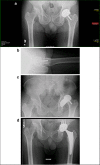Conversion of a failed hip resurfacing arthroplasty to total hip arthroplasty: pearls and pitfalls
- PMID: 26803608
- PMCID: PMC4762797
- DOI: 10.1007/s12178-016-9326-y
Conversion of a failed hip resurfacing arthroplasty to total hip arthroplasty: pearls and pitfalls
Abstract
Surface replacement arthroplasty (SRA) remains a viable alternative to total hip arthroplasty (THA) in appropriately selected, active adults with degenerative hip disease. However, orthopedic surgeons are facing a number of scenarios where revision of one or both components of an SRA is indicated. Indications for revision vary and impact the potential outcomes of conversion of a SRA to THA. While clinical outcomes are generally favorable, a growing body of data illustrates patients who undergo conversion of a SRA to THA to be at increased risk of requiring a repeat revision surgery and experiencing functional outcomes inferior to that of a primary THA. The results of patients undergoing conversion of a SRA to THA highlight the need for careful patient selection, thorough preoperative counseling, and technical precision when performing a SRA. Furthermore, a systematic approach to the failed SRA is necessary to ensure optimal clinical results.
Keywords: Aseptic loosening; Femoral neck fracture; Metallosis; Surface replacement arthroplasty; Total hip arthroplasty.
Figures

Similar articles
-
Is there evidence to support an indication for surface replacement arthroplasty?: a systematic review.Bone Joint J. 2019 Jan;101-B(1_Supple_A):32-40. doi: 10.1302/0301-620X.101B1.BJJ-2018-0508.R1. Bone Joint J. 2019. PMID: 30648490
-
Complication Rates of Hemiarthroplasty Conversion to Total Hip Arthroplasty Versus Primary Total Hip Arthroplasty.Orthop Rev (Pavia). 2021 Jul 10;13(2):25539. doi: 10.52965/001c.25539. eCollection 2021. Orthop Rev (Pavia). 2021. PMID: 34745478 Free PMC article.
-
Is the Survivorship of Birmingham Hip Resurfacing Better Than Selected Conventional Hip Arthroplasties in Men Younger Than 65 Years of Age? A Study from the Australian Orthopaedic Association National Joint Replacement Registry.Clin Orthop Relat Res. 2020 Nov;478(11):2625-2636. doi: 10.1097/CORR.0000000000001453. Clin Orthop Relat Res. 2020. PMID: 32898048 Free PMC article.
-
Outcomes after revision of metal on metal hip resurfacing to total arthroplasty using the direct anterior approach.Int Orthop. 2018 Nov;42(11):2543-2548. doi: 10.1007/s00264-018-3858-2. Epub 2018 Mar 8. Int Orthop. 2018. PMID: 29520467
-
A Meta-Analysis of Outcomes in Total Hip Arthroplasty Recipients Following Pelvic Irradiation.J Arthroplasty. 2019 Jul;34(7):1546-1552. doi: 10.1016/j.arth.2019.02.047. Epub 2019 Feb 27. J Arthroplasty. 2019. PMID: 30904364
Cited by
-
Can hip resurfacing be safely revised with short-stem total hip arthroplasty? A case series of six patients.J Orthop. 2021 Mar 26;24:274-279. doi: 10.1016/j.jor.2021.03.007. eCollection 2021 Mar-Apr. J Orthop. 2021. PMID: 33897129 Free PMC article.
-
Poor outcomes for osteoporotic patients undergoing conversion total hip arthroplasty following prior failed dynamic hip screw fixation: a nationwide retrospective cohort study.J Int Med Res. 2019 Apr;47(4):1544-1554. doi: 10.1177/0300060518823410. Epub 2019 Jan 23. J Int Med Res. 2019. PMID: 30669904 Free PMC article.
-
Revision of Metal-on-metal Hip Arthroplasty with Well Fixed and Positioned Acetabular Component Using a Dual-mobility Head and Review of Literature.Open Orthop J. 2016 Oct 31;10:512-521. doi: 10.2174/1874325001610010512. eCollection 2016. Open Orthop J. 2016. PMID: 27857822 Free PMC article.
References
-
- McKee GK, Watson-Farrar J. Replacement of arthritic hips by the McKee-Farrar prosthesis. J Bone Joint Surg (Br) 1966;48(2):245–59. - PubMed
LinkOut - more resources
Full Text Sources
Other Literature Sources

